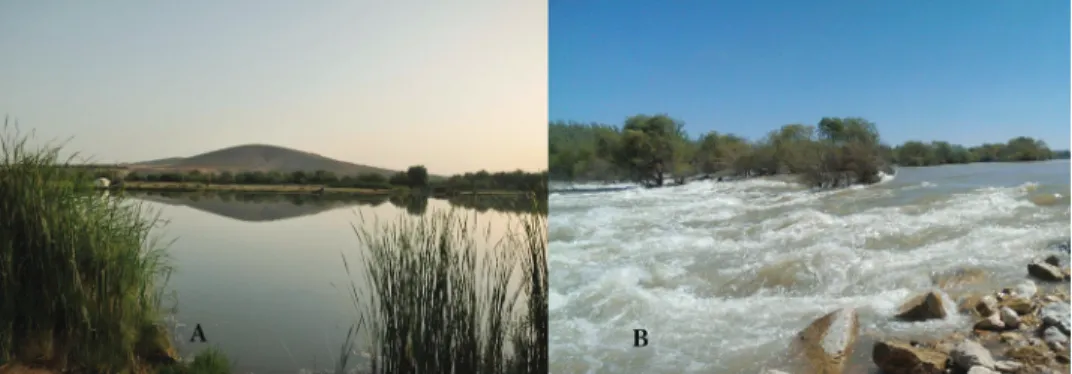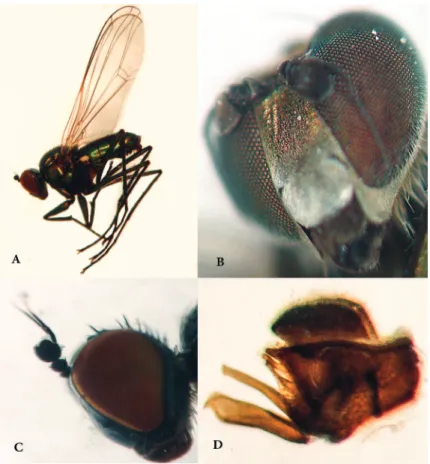Study of the Family Dolichopodidae in Grasslands of Miandoab County, Iran
E. HAMED1, S. KHAGHANINIA1* and F. KAZERANI2
1Department of Plant Protection, Faculty of Agriculture, University of Tabriz, 51664, Tabriz, I.R. Iran
2Research Institute of Forests and Rangelands, Agricultural Research Education and Extension Organization (AREEO), Tehran, I.R. Iran.
(Received: 22 June 2017; accepted: 10 August 2017)
During studies of Diptera in the grasslands of Miandoab County, West Azerbaijan province, Iran, dur- ing 2014-2015, 10 species of the family Dolichopodidae have been identified that among them Hydrophorus callostomus Loew, 1857 is recorded for the first time from Iran.
Keywords: Diptera, Dolichopodidae, Iran, Miandoab, new record.
Dolichopodidae has approximately 7500 described species and 250 genera in the world (Pape et al., 2009). Adults and larvae of this family are predators (except of Thryp- ticus spp.) of insects with soft bodies like aphids, cocccids and etc. (Pollet, 2001). Adults are found on the broad-leaved vegetation and humid areas, whereas larvae occur mostly in mud, humid soils and among leaf litter (Dyte, 1959; Pollet, 1992). Contrary to this pattern, most Medetera species are confined to vertical structures and tree trunks, larvae of many species live in the subcortical galleries of bark beetles and feed on all stages of these beetles, so they can be an important biological agent for controlling bark beetles (Bickel, 1985).
Body size of adult dolichopodids is various from about 1-9 mm in length and they can be identified by their elongate legs, reduced wing venation, aristate antennae, and rel- atively slender build. Most species are metallic greenish-blue to greenish-bronze. Males have various secondary sexual characteristics which can be important features for recog- nizing species. The male hypopygium is either somewhat small covered by abdominal segments, or large and pedunculated (Brooks, 2005).
The studies demonstrate that dolichopodids have very specific habitat require- ments and react quickly to environmental alterations, making them potentially useful as bio-indicators for site quality assessment and conservation purposes (Pollet, 2001; Gelbič and Olejníček, 2010). The fauna of the family Dolichopodidae in Iran has not been fully studied until now. Recently the most important studies have been done by Kazerani et al. (2014, 2017) and Kazerani (2015) in a large scale from Northern west (including Ar- asbaran forests) to Northern (including Hyrcanian forests) of Iran that improved Iranian
checklist to 136 species in 22 genera. As the Fauna of Dolichopodidae had not been inves- tigated in Miandiab County, the objective of this study is to improve our knowledge about fauna of long-legged flies in the region.
Materials and Methods
Material for this study has been collected from Miandoab county in West Azerbaijan province, Iran during 2015–2016 using sweeping net, from March to September (Fig. 1 A-B). Miandoab is situated in a delta region of the two rivers Zarrineh-Rud and Simineh- Rud and located in the center of the plain that slopes down to Lake Urmia. This area has a
very fertile soil and Mediterranean climate. This area has unique fauna and flora and signif- icant diversity of native plant species. The material was preserved in 75% ethanol in glass vials. The specimens were identified using follows D’Assis Fonseca (1978), McAlpine (1981) and Cumming and Wood (2009). All the studied materials are deposited on insect collection of Prof. Hassan Maleki Milani (ICHMM), Tabriz university, Tabriz, Iran.
Results
In all 10 species have been collected and identified. List of the collected species are provided alphabetically.
1. Asyndetus latifrons (Loew, 1857)
Material examined: 1♀ and 2♂, West Azerbaijan province, Miandoab, Qare-varan (36°57'02.4"N 46°07'42.0"E, 1292 m), 20.IV.2016; 5♂, (36°56'44.0"N 46°07'57.5"E, 1296 m), 14.VI.2015, leg. E. Hamed.
Fig. 1. A-B. Zarrineh-Rud and its surrounding area in Miandoab County, where the material for this study has been collected
2. Campsicnemus curvipes (Fallén, 1823)
Material examined: 1♂, West Azerbaijan province, Miandoab, Nasir Kandi (36°56'34.5"N 46°10'13.6"E, 1300 m.a.s.l.), 14.VI.2015; 1♂, (36°56'46.8"N 46°10'10.7"E, 1306 m.a.s.l.), 12.VI.2015, leg. E. Hamed.
3. Chrysotus cilipes Meigen, 1824
Material examined: 1♀ and 1♂, West Azerbaijan province, Miandoab, Hey- dar Abad (36°55'47.8"N, 46°09'08.0"E, 1295 m.a.s.l.) 10.V.2015; 4♂, (36°56'05.7"N 46°08'56.0"E, 1296 m.a.s.l.), 24. IV. 2015, leg. E. Hamed.
4. Dolichopus nubilus Meigen, 1824
Material examined: 3♂, West Azerbaijan province, Miandoab, Heydar Abad (36°56'05.7"N 46°08'56.0"E, 1296 m.a.s.l.), 24. IV. 2015, leg. E. Hamed.
5. Dolichopus simplex Meigen, 1824
Material examined: 3♀ and 1♂, West Azerbaijan province, Miandoab, Nowrou- zlu (36°55'44.8"N 46°10'23.2"E, 1298 m.a.s.l.), 18. VI. 2016; 5♀ and 2♂, Nasir Kandi (36°56'34.5"N 46°10'13.6"E , 1300 m.a.s.l.), 14. VI. 2015; 4♀ and 3♂, (36°56'46.8"N 46°10'10.7"E , 1306 m.a.s.l.), 12.VI.2015, 2♂, Miandoab, Qare-varan (36°57'02.4"N 46°07'42.0"E, 1292 m), leg. E. Hamed.
6. Hydrophorus balticus (Meigen, 1824)
Material examined: 1♀ and 1♂, West Azerbaijan province, Miandoab, Nasir Kandi (36°56'34.5"N 46°10'13.6"E, 1300 m.a.s.l.), 14.VI.2015; 1♂, Nowrouzlu (36°55'44.8"N 46°10'23.2"E, 1298 m.a.s.l.), 18. VI. 2016, leg. E. Hamed.
7. Hydrophorus callostomus Loew, 1857*
Material examined: 2♂, West Azerbaijan province, Miandoab, Heydar Abad (36°56'05.7"N 46°08'56.0"E, 1296 m.a.s.l.), 24. IV. 2015, leg. E. Hamed.
Diagnostic characters: face dichromatic: the colour of epistome strongly differs from colouring of clypeus (Fig. 2B); antenna black (Fig. 2C); Fore coxae with light hairs;
wings hyaline (Fig. 2A); halter yellow (Fig. 2A); lateral lobe of surstylus narrow; hypan- drium bandlike (Fig. 2D).
8. Medetera meridionalis Negrobov, 1967
Material examined: 2♀ and 3♂, West Azerbaijan province, Miandoab, Qare- varan (36°56'44.0"N 46°07'57.5"E, 1296 m), 14. VI. 2015, leg. E. Hamed.
9. Poecilobothrus armeniorum (Stackelberg, 1934)
Material examined: 1♂, West Azerbaijan province, Miandoab, Heydar Abad (36°56'05.7"N 46°08'56.0"E, 1296 m.a.s.l.), 24. IV. 2015, leg. E. Hamed.
10. Syntormon pallipes (Fabricius, 1794)
Material examined: 4♀ and 2♂, West Azerbaijan province, Miandoab, Now- rouzlu (36°55'44.8"N 46°10'23.2"E, 1298 m.a.s.l.), 18. VI. 2016; 3♀ and 2♂, Nasir Kandi (36°56'34.5"N 46°10'13.6"E, 1300 m.a.s.l.), 14. VI. 2015; 6♀, (36°56'46.8"N 46°10'10.7"E, 1306 m.a.s.l.), 12.VI.2015, 7♂, Miandoab, Qare-varan (36°57'02.4"N 46°07'42.0"E, 1292 m), leg. E. Hamed.
Fig. 2. Hydrophorus callostomus Loew, 1857: A) Male habitus lateral view, B) head in frontal (lower) view, C) head in lateral view, D) Genitalia in lateral view
Discussion
In this study we found 10 species belong to 8 genera from Miandoab grasslands and the species Hydrophorus callostomus Loew, 1857 is newly recorded from Iran and distributed in North Europe and East Europe, Russia and Caucasus (Armenia, Turkey).
Most studied species are distributed wildly in Europe and Asia. Some species like P. ar- meniorum is recorded just from South of Russia, Armenia and Iran (Khaghaninia et al., 2013; Negrobov (1991); Yang et al., 2006; Pollet, 2001).
Based on Kazerani (2015) the genera Asyndetus and Syntormon have the most fre- quency in north and northern-west of Iran, in this study S. pallipes and A. latifrons have the most frequency in the studied area. Totally 53 species have been identified 43 species from Palearctic region (Yang et al., 2006). By the present time only two species of the genus Hydrophorus Fallén, 1823 were recorded from Iran (Grichanov et al., 2010; Kaze- rani et al. 2014a), in this study it has increased to 3 species.
Larvae of Hydrophorinae are predators and thought to be aquatic (Hurley, 1985).
Species of the genus Hydrophorus usually occur in littoral and coastal habitats or near waterfalls, and many species are seen skating on the water surface (Naglis, 2012). As Mi- andoab region is located between two rivers (Zarrineh-Rud and Simineh-Rud) and Urmia lake, so this area has humid wheatear, this condition is appropriate for development of hydrophilic species like Hydrophorus spp.
Due to special fauna and flora of Miandoab region, it is obvious that this area has good potential of fauna and flora, so further studies to know dolichopodids fauna is nec- essary in this region.
Literature
Bickel, D. J. (1985): A revision of the Nearctic Medetera (Diptera: Dolichopodidae). U.S. Department of Agri- culture, Technical Bulletin. 1692, 1–109.
Brooks, S. E. (2005): Systematics and phylogeny of Dolichopodinae (Diptera: Dolichopodidae). Zootaxa 857, 158 p.
Cumming, J. M. and Wood D. M. (2009): Adult morphology and terminology. In: B. V. Brown, A. Borkent, J. M.
Cumming, D. M. Wood, N. E. Woodly and M. A. Zumbado (eds): Manual of Central American Diptera.
NRC Research Press, Ottawa, Ontario, Canada, Vol. 1., pp. 9–50.
D’Assis Fonseca, E. C. M. (1978): Diptera Orthorrhapha Brachycera. V. Dolichopodidae. – Handbooks for the identification of British insects. Cambridge, IX. part. 5, 1–90.
Dyte, C. E. (1959): Some interesting habitats of larval Dolichopodidae (Diptera). Entomologist’s Monthly Mag- azine. 95, 139–143.
Gelbič, I. and Olejníček, J. (2010): Ecology of Dolichopodidae (Diptera) in a wetland habitat and their potential role as bioindicators. Central European J. Biology 6, 118–129.
Grichanov, I. Ya., Alikhani, M. and Rabieh, M. M. (2010): New data on the distribution of Dolichopodidae (Dip- tera) in Iran. An International J. Dipterological Research. 21, 195–201.
Hurley, R. L. (1985): Orthogenya, Dolichopodidae: Hydrophorinae. In: G. C. D. Griffith (eds): Flies of the Nearctic Region. Schweizerbart Science Publisher: Stuttgart, Germany, 112 p.
Kazerani, F. (2015): Taxonomy and species diversity of field and collection specimens of the family Dolichopo- didae (Dip., Empidoidea) in some parts of northern and northern west of Iran. PHD dissertation, Tabriz University, 336 p.
Kazerani, F., Khaghaninia, S., Talebi, A. A. and Grichanov, I. (2014): Genus Sciapus Zeller, 1842 (Diptera:
Dolichopodidae) in Iran, with description of a new species and new records. Acta Entomologica Museum Prague. 55, 401–409.
Kazerani, F., Khaghaninia, S., Talebi, A. A., Gharajedaghi, Y. and Grichanov, I. (2014a): New records of long legged flies (Diptera, Dolichopodidae) from Iran. Acta Entomologica Serbica 19, 25–32.
Kazerani, F., Khaghaninia, S., Talebi, A. A., Persson, M. and Pollet, M. (2017): Eight new species of Dolichopo- dinae (Diptera: Dolichopodidae) from northern Iran. Zootaxa. 4242, 111–141.
Khaghaninia, S., Gharajedaghi, Y. and Grichanov, I. Y. (2013): Additional notes about long-legged flies (Dip- tera: Dolichopodidae) in East Azerbaijan province of Iran. Biharean Biologist. 7, 42–47.
McAlpine, J. F. (1981): Morphology and terminology – adults In: J. F. McAlpine, B. V. Peterson, G. E. Shewell, H. J. Teskey, J. R. Vockeroth and D. M. Wood (eds): Manual of Nearctic Diptera Agriculture Canada Monograph Vol. 1., pp. 9–63.
Naglis, S. (2012): New records of Hydrophorinae (Diptera, Dolichoppdidae) from Turkey, with the description of a new species of Scellus Loew. Mitteilungen–Schweizerische Entomologische Gesellschaft. 85, 45–49.
Negrobov, O. P. (1991): Dolichopodidae. In: A. Soos, and L. Papp (eds): Catalogue of Palaearctic Diptera.
Dolichopodidae – Platypezidae. Akademiai Kiado, Budapest, Vol. 7., pp. 11–139.
Pape, T., Bickel, D. and Meier, R. (2009): Diptera Diversity: Status, Challenges and Tools. Koninklijke Brill NV., Leiden, 459 p.
Pollet, M. (1992): Impact of environmental variables on the occurrence of dolichopodid flies in marshland hab- itats in Belgium (Diptera: Dolichopodidae). J. Natural History. 26, 621–636.
Pollet, M. (2001): Dolichopodid biodiversity and site quality assessment of reed marshes and grasslands in Bel- gium (Diptera: Dolichopodidae). J. Insect Conservation 5, 99–116.
Yang, D., Zhu, Y., Wang, M. and Zhang, L. (2006): World Catalog of Dolichopodidae (Insecta: Diptera). Agri- cultural University Press, China, 704 p.

